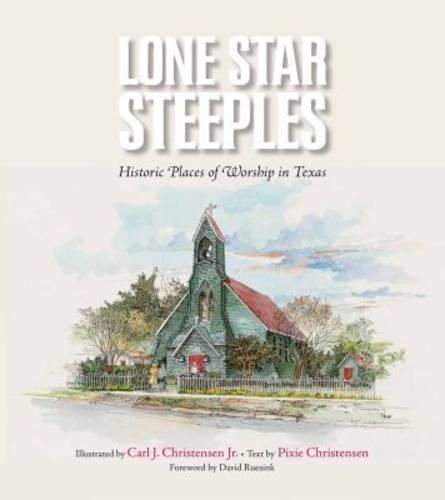Readings Newsletter
Become a Readings Member to make your shopping experience even easier.
Sign in or sign up for free!
You’re not far away from qualifying for FREE standard shipping within Australia
You’ve qualified for FREE standard shipping within Australia
The cart is loading…






In Lone Star Steeples: Historic Places of Worship in Texas, Carl J. Christensen Jr. and Pixie Christensen present sixty-fivecaptivating and historically significant structures in exquisitewatercolor illustrations accompanied by brief summaries andconvenient, handcrafted maps. Ranging from stately edifices ofbrick and stone located in urban centers to more humble woodframechapels in rural surroundings, the houses of faith shown inthese pages have one important trait in common: They have allserved as centers of cultural identity, spiritual comfort, and publicservice to the communities in which they arose.
In their introduction, the Christensens write, The journey behindLone Star Steeples crisscrossed the state along back roads, farm roads, and state highways. In these journeys and in the storiesthat were told, certain patterns began to emerge: the pride of thepeople in building their churches debt-free, the perseverance ofthe people who endured their beloved church being destroyed bynatural disaster once, twice, or even three times … the people'srecognition of the church as their cultural foundation, theirmoral foundation, their social center. As the Christensensdemonstrate, Texas is home to a remarkable diversity ofpeople, and their places of worship reflect and celebrate thatdiversity.
$9.00 standard shipping within Australia
FREE standard shipping within Australia for orders over $100.00
Express & International shipping calculated at checkout
In Lone Star Steeples: Historic Places of Worship in Texas, Carl J. Christensen Jr. and Pixie Christensen present sixty-fivecaptivating and historically significant structures in exquisitewatercolor illustrations accompanied by brief summaries andconvenient, handcrafted maps. Ranging from stately edifices ofbrick and stone located in urban centers to more humble woodframechapels in rural surroundings, the houses of faith shown inthese pages have one important trait in common: They have allserved as centers of cultural identity, spiritual comfort, and publicservice to the communities in which they arose.
In their introduction, the Christensens write, The journey behindLone Star Steeples crisscrossed the state along back roads, farm roads, and state highways. In these journeys and in the storiesthat were told, certain patterns began to emerge: the pride of thepeople in building their churches debt-free, the perseverance ofthe people who endured their beloved church being destroyed bynatural disaster once, twice, or even three times … the people'srecognition of the church as their cultural foundation, theirmoral foundation, their social center. As the Christensensdemonstrate, Texas is home to a remarkable diversity ofpeople, and their places of worship reflect and celebrate thatdiversity.